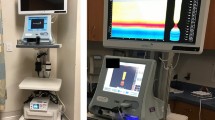Abstract
Background
Pediatric esophageal stenosis can be challenging to manage due to post-dilation tissue response involving fibroblast activity resulting in scar reformation. The functional lumen imaging probe (FLIP) uses high-resolution impedance planimetry to measure key luminal parameters during a volume-controlled distension. We sought to evaluate the safety as well as possible settings of EndoFLIP and EsoFLIP in the pediatric population.
Method
We performed a retrospective chart review of all patients that had EndoFLIP (with and without balloon dilation) or EsoFLIP done between July 2017 and May 2018.
Results
Eighteen patients were identified and 19 FLIP procedures were performed during esophagogastroduodenoscopy (10 EndoFLIP, 6 EndoFLIP + traditional balloon dilation, 3 EsoFLIP). Median age for the population was 13.7 years. Dysphagia was the most common chief complaint prior to endoscopic intervention. EndoFLIP measurements were most commonly taken at 20 ml and/or 30 ml of infusion. Diameter, compliance, cross-sectional area, and distensibility index were similar between infusion volumes. Median procedure time of the EndoFLIP + traditional balloon dilation group was longer (60.5 min) than the median procedure time of the EsoFLIP group (35 min, p = 0.12). Median fluoroscopy time of the EndoFLIP + traditional balloon dilation group was 0.6 min and the median fluoroscopy time of the EsoFLIP group was 0.5 min (p = 0.79). EndoFLIP + traditional balloon dilation was associated with a smaller diameter increase compared to EsoFLIP (2.2 mm vs. 4 mm; p = 0.09). There were no complications.
Conclusion
Functional lumen imaging probe (FLIP) can safely provide important luminal measurements in pediatric patients with esophageal stenosis, and may guide therapy. Esophageal dilation using EsoFLIP may yield a larger diameter change and may potentially reduce procedure time when compared to traditional balloon dilation. Pediatric patients with epidermolysis bullosa and esophageal stenosis responded well to EsoFLIP dilation.

Similar content being viewed by others
Change history
25 June 2019
This article has been corrected to include the middle initial of senior author Mouen A. Khashab.
Abbreviations
- CRE:
-
Controlled radial expansion
- CSA:
-
Cross-sectional area
- EB:
-
Epidermolysis bullosa
- EGD:
-
Esophagogastroduodenoscopy
- FLIP:
-
Functional lumen imaging probe
- LES:
-
Lower esophageal sphincter
References
Menard-Katcher C, Furuta GT, Kramer RE (2017) Dilation of pediatric eosinophilic esophagitis: adverse events and short-term outcomes. J Pediatr Gastroenterol Nutr 64(5):701–706. https://doi.org/10.1097/MPG.0000000000001336
Landisch RM, Foster S, Gregg D et al (2017) Utilizing stricture indices to predict dilation of strictures after esophageal atresia repair. J Surg Res 216:172–178. https://doi.org/10.1016/j.jss.2017.04.024
Lamoria S, De A, Agarwal S, Lamba BMS, Sharma V (2016) Peptic esophageal stricture in an adolescent with Barrett’s esophagus. Int J Adolesc Med Health. https://doi.org/10.1515/ijamh-2015-0106
Gollu G, Ergun E, Ates U, Can OS, Dindar H (2017) Balloon dilatation in esophageal strictures in epidermolysis bullosa and the role of anesthesia. Dis Esophagus 30(3):1–6. https://doi.org/10.1111/dote.12503
Abreu M, Nunes I, Corujeira S, Tavares M, Trindade E, Dias JA (2016) Caustic esophageal stenosis: a case report of endoscopic dilation with a dynamic stent. GE Port J Gastroenterol 23(4):218–223. https://doi.org/10.1016/j.jpge.2015.12.006
Manfredi MA (2016) Endoscopic management of anastomotic esophageal strictures secondary to esophageal atresia. Gastrointest Endosc Clin 26(1):201–219. https://doi.org/10.1016/j.giec.2015.09.002
Manfredi MA, Jennings RW, Anjum MW, Hamilton TE, Smithers CJ, Lightdale JR (2014) Externally removable stents in the treatment of benign recalcitrant strictures and esophageal perforations in pediatric patients with esophageal atresia. Gastrointest Endosc 80(2):246–252. https://doi.org/10.1016/j.gie.2014.01.033
Manfredi MA, Clark SJ, Medford S et al (2018) Endoscopic electrocautery incisional therapy as a treatment for refractory benign pediatric esophageal strictures. J Pediatr Gastroenterol Nutr. https://doi.org/10.1097/mpg.0000000000002008
Hirano I, Pandolfino JE, Boeckxstaens GE (2017) Functional lumen imaging probe for the management of esophageal disorders: expert review from the clinical practice updates committee of the AGA institute. Clin Gastroenterol Hepatol 15(3):325–334. https://doi.org/10.1016/j.cgh.2016.10.022
Ahuja NK, Agnihotri A, Lynch KL et al (2017) Esophageal distensibility measurement: impact on clinical management and procedure length. Dis Esophagus 30(8):1–8. https://doi.org/10.1093/dote/dox038
Taylor JS, Danzer E, Berquist WE, Wall JK (2018) Dilation of esophageal stricture in a pediatric patient using functional lumen imaging probe technology without the use of fluoroscopy. J Pediatr Gastroenterol Nutr. https://doi.org/10.1097/mpg.0000000000001936
Hanna AN, Datta J, Ginzberg S, Dasher K, Ginsberg GG, Dempsey DT (2018) Laparoscopic heller myotomy versus per oral endoscopic myotomy: patient-reported outcomes at a single institution. J Am Coll Surg. https://doi.org/10.1016/j.jamcollsurg.2017.12.050
Menard-Katcher C, Benitez AJ, Pan Z et al (2017) Influence of age and eosinophilic esophagitis on esophageal distensibility in a pediatric cohort. Am J Gastroenterol 2(suppl):61. https://doi.org/10.1038/ajg.2017.131
Leroi AM, Melchior C, Charpentier C et al (2018) The diagnostic value of the functional lumen imaging probe versus high-resolution anorectal manometry in patients with fecal incontinence. Neurogastroenterol Motil 30(6):e13291. https://doi.org/10.1111/nmo.13291
Ata-Lawenko RM, Lee YY (2017) Emerging roles of the endolumenal functional lumen imaging probe in gastrointestinal motility disorders. J Neurogastroenterol Motil 23(2):164–170. https://doi.org/10.5056/jnm16171
Author information
Authors and Affiliations
Contributions
KN was the primary author of the manuscript including creation of the tables and figure. DM helped edit the manuscript, figure, and tables, providing valuable feedback to help shape the work. JH helped edit the manuscript, figure, and tables, providing valuable feedback. MK oversaw the project and also helped edit the manuscript, figure, and tables.
Corresponding author
Ethics declarations
Disclosures
Dr. Kenneth Ng is a consultant for Medtronic. Dr. Mouen A. Khashab is a consultant for Olympus, Boston Scientific, and Medtronic. Drs. Douglas Mogul and John Hollier have no conflicts of interest or financial ties to disclose.
Additional information
Publisher's Note
Springer Nature remains neutral with regard to jurisdictional claims in published maps and institutional affiliations.
This article has been corrected to include the middle initial of senior author Mouen A. Khashab.
Rights and permissions
About this article
Cite this article
Ng, K., Mogul, D., Hollier, J. et al. Utility of functional lumen imaging probe in esophageal measurements and dilations: a single pediatric center experience. Surg Endosc 34, 1294–1299 (2020). https://doi.org/10.1007/s00464-019-06898-5
Received:
Accepted:
Published:
Issue Date:
DOI: https://doi.org/10.1007/s00464-019-06898-5




